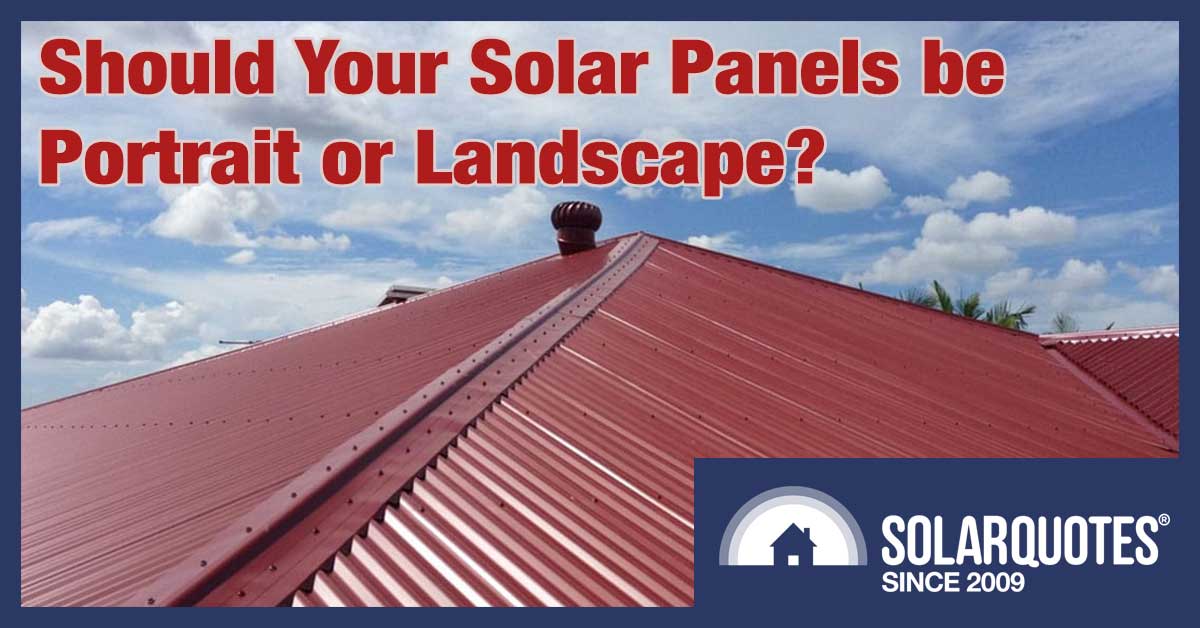
Have you ever noticed that most solar panels installed on Australian roofs are mounted in portrait orientation?
Portrait is more popular because solar panels are cheaper and quicker to install this way.
This post will explain why panel orientation can matter, and why you may be better off with landscape panels despite the extra effort required to install them.
Note: This post is not about energy yield. In terms of energy yield, an unshaded portrait panel will generate the same as a landscape solar panel1.
Solar Panels: Portrait Vs. Landscape
Imagine you want to put 11 solar panels on a typical Colorbond roof.
You could install them portrait like this:
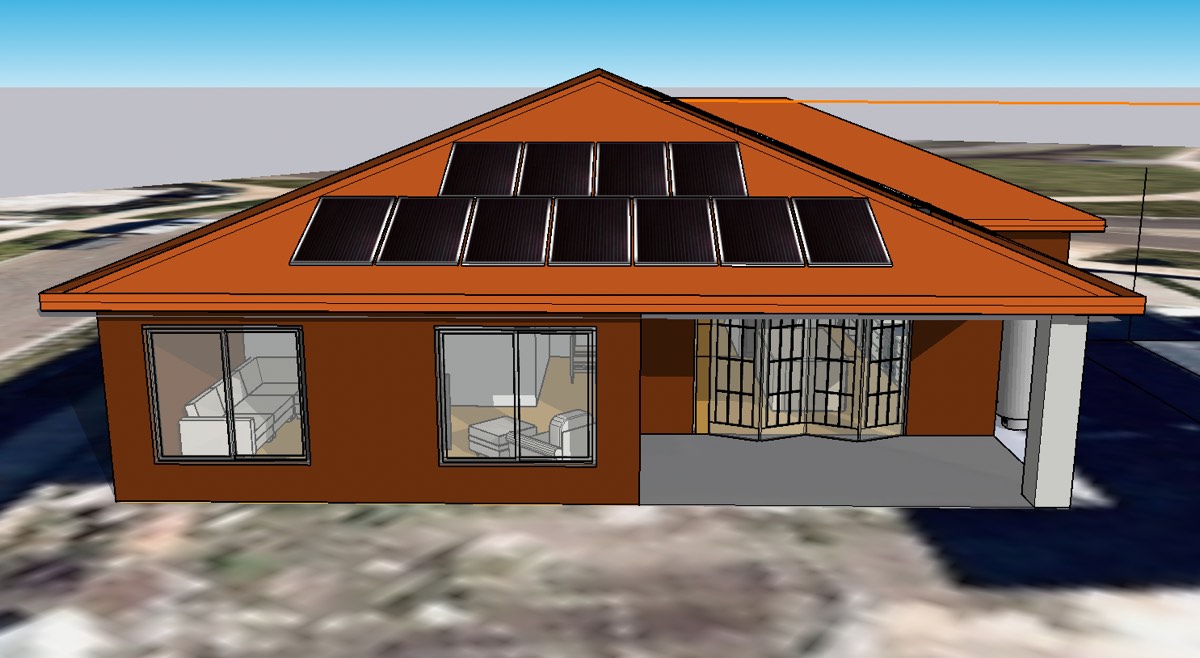
A simple portrait orientation solar installation. House Model Credit: Juan Sanchez
Or landscape:
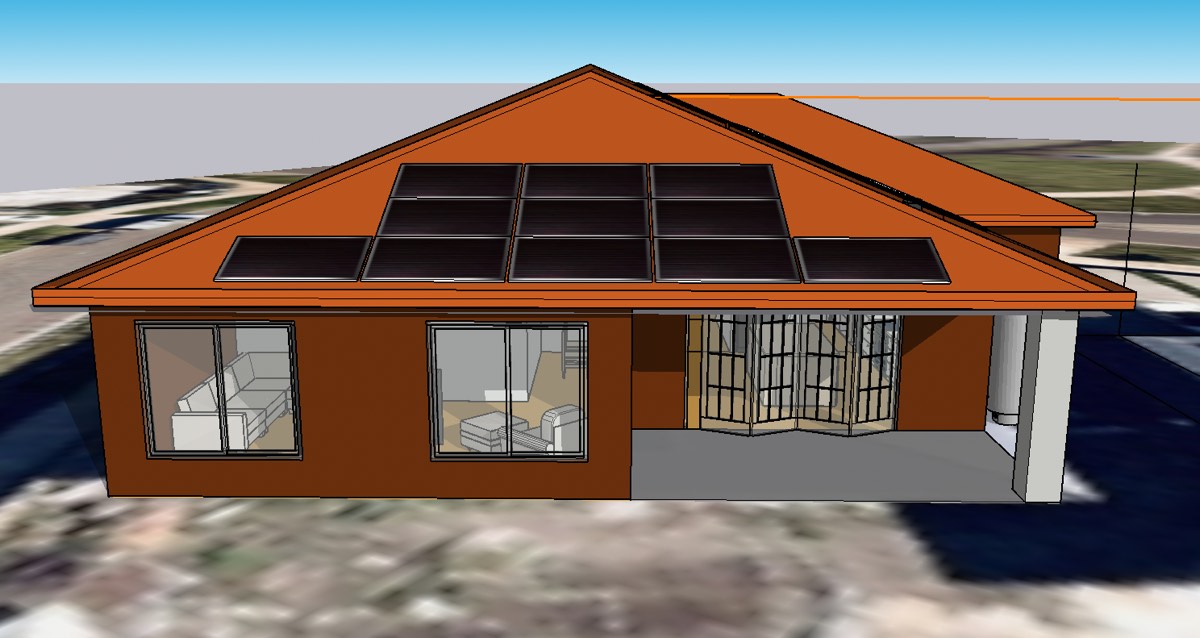
A simple landscape solar panel installation
Is one orientation better than the other?
For the roof in the two images above, almost all installers will choose to install in portrait orientation. That’s because it is cheaper and quicker to install this way. In fact, a landscape install can take 50% longer.
Here’s why. With a portrait install, the installer will need to cut and mount 4 lengths of rail, and use 26 clamps to mount the panels:
For landscape, the installer needs to use 10 lengths of rail and 32 panel-clamps2:
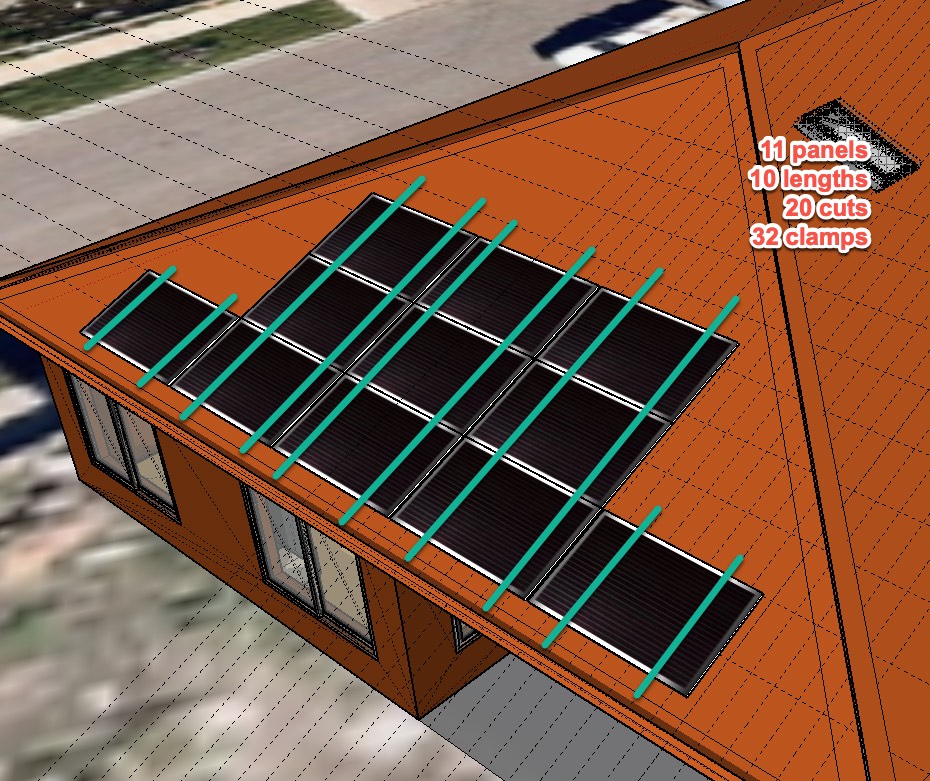
This image shows where the mounting rails would typically go on a landscape installation. On some roofs it may be possible to use 6 rails parallel with the long edge of the panels – but the roof’s screwline spacing and the clamping zones can make that difficult to achieve.
So, with the extra effort required for a landscape install, why choose landscape at all?
The answer is space efficiency. On many roofs, landscape will let you mount more solar panels in the same space while still respecting their clamping zones and the roof’s exclusion zones.
This means you can get more energy from the same roof.
Here’s an example using the same roof as before.
WIth portrait orientation and respecting a 200mm exclusion zone around the roof-edge, we can fit 12 panels.
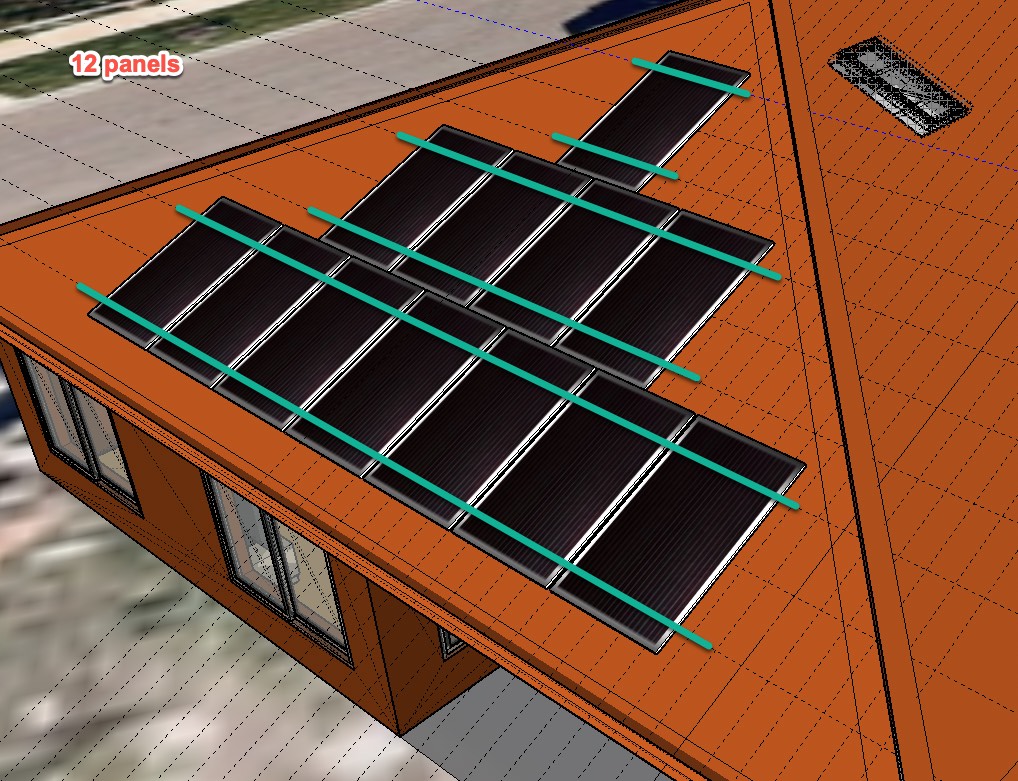
12 portrait panels will fit on this roof respecting exclusion and clamping zones..
WIth landscape orientation, we can fit 15.
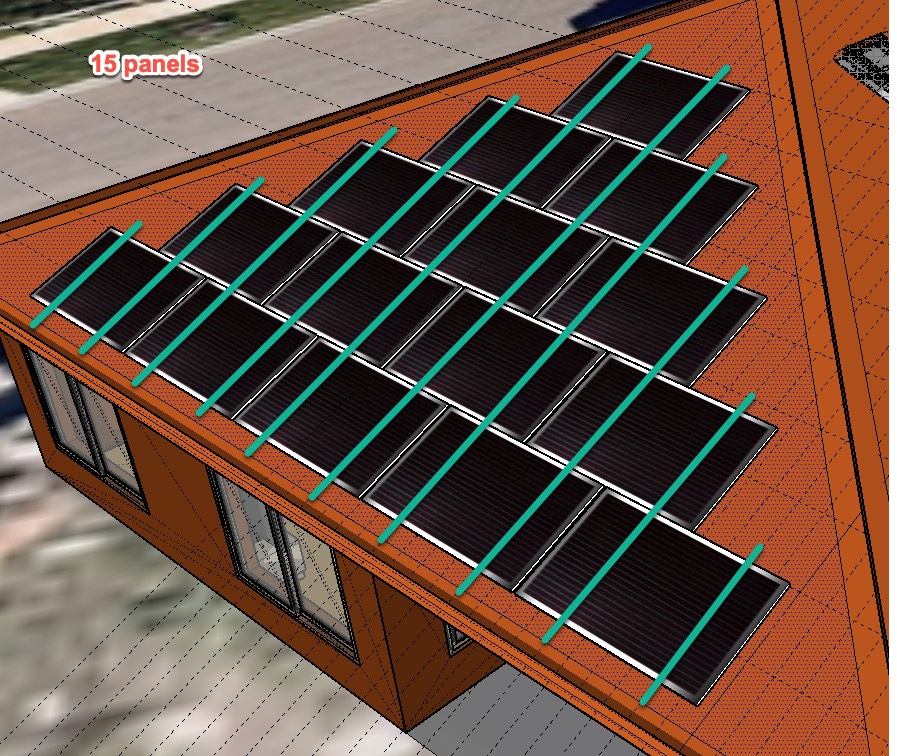
15 landscape panels will fit on this roof respecting exclusion and clamping zones.
Extra kilowatts from landscape can be substantial
Let’s now look at an example on a full roof with some complicated roof faces.
With a portrait install, we can fit 47 panels3:
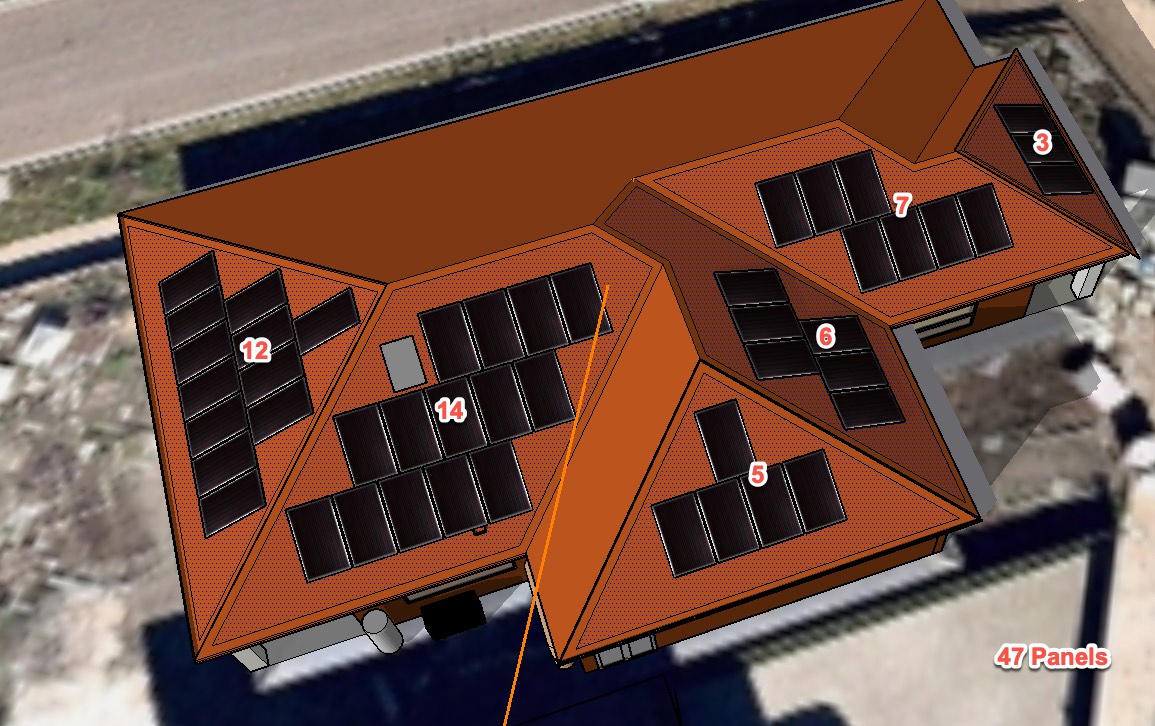
47 portrait panels fit on this house (excluding south roof)
With a landscape install, we can fit 57. If they are 400 watt solar panels, that’s an extra 4 kW on the roof.
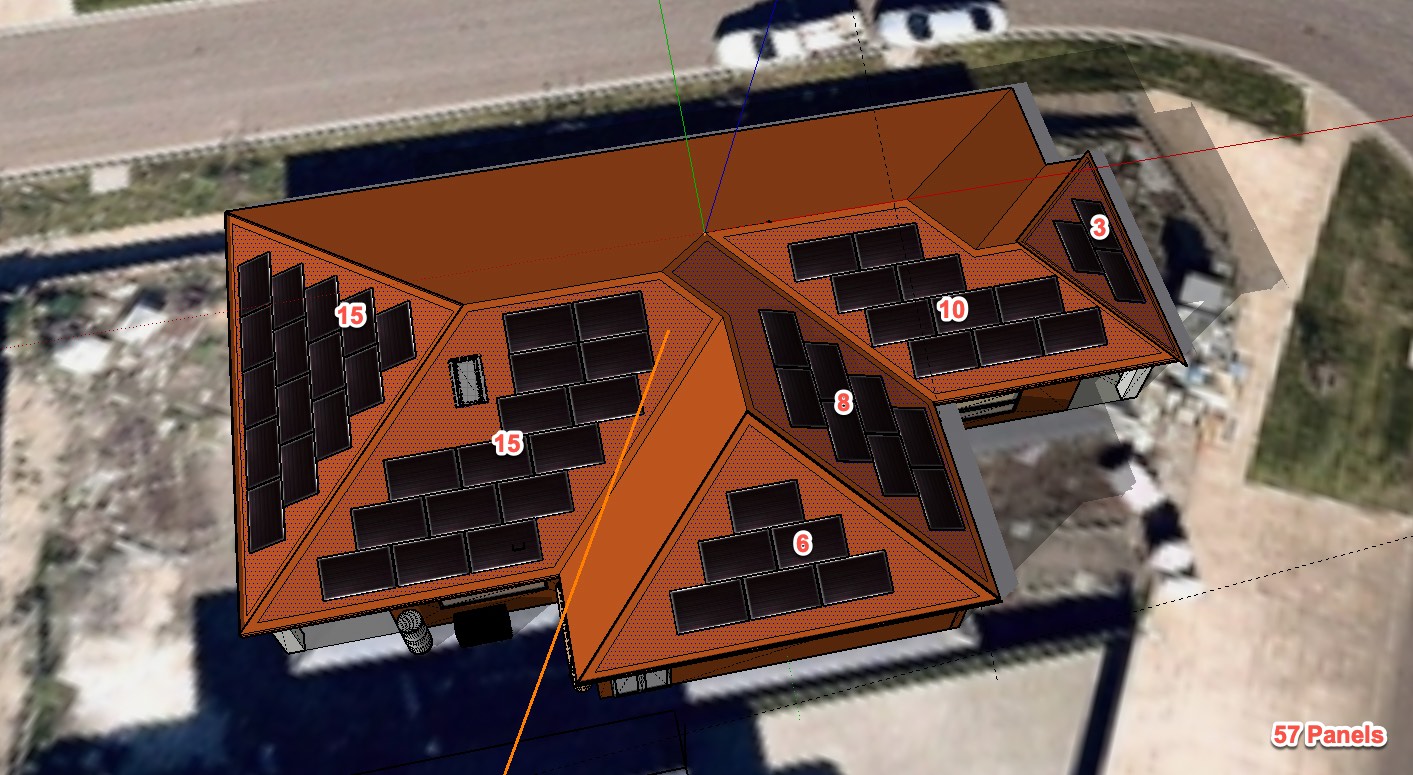
57 landscape panels fit on this house (excluding south roof)
Rushed installers won’t install landscape solar panels
One of the problems with getting the cheapest quote is the installers don’t have the time or the inclination to install in landscape orientation.
To fit all the solar panels you’ve been sold on to your roof they may have to:
- force them to fit in portrait, violating either the panel clamping zones or the roof exclusion zones, or both.
- tell you you can’t have all the panels you’ve been promised because they won’t fit.
Imagine you’ve been quoted 15 panels for the roof below. If the salesperson has only looked at your roof on Google Maps, it will look like they will easily fit in portrait.
But here’s what can happen when the installer has been told to install them and is in a hurry:
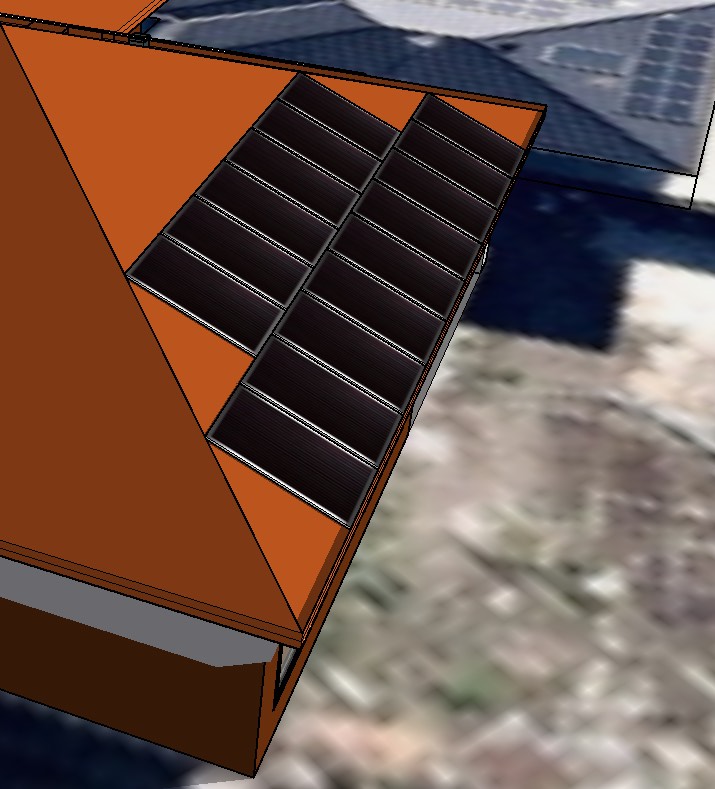
Exclusion zones violated! I see this all the time on rushed installs.
This is the quickest and cheapest way for a rushed installer to install those 15 panels. Unfortunately, to squeeze them in, the installer has violated the 200mm exclusion zone that is generally required to meet AS 5033, the Australian Standard for solar installations.
The install is non-compliant, looks shit, and when it rains the water that hits the solar panels will likely pour off the bottom row like a little waterfall, missing your gutter altogether.
Also – if the roof’s existing screw-lines are not in a convenient position relative to the panels, you may have panel clamps in the wrong place, relative to the panel’s short edge – voiding the solar panel manufacturer’s warranty.
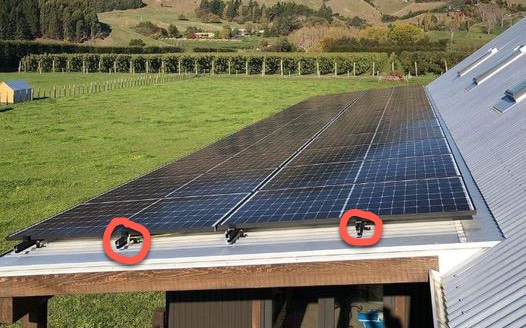
‘Diving board’ panel install. The circled clamps are too far away from the right hand edge of the panels. They are likely to flex in the wind, and the installer will have a hard job making a warranty claim with the manufacturer if they fail.
Be wary of salespeople who don’t consider landscape
Sometimes we’re asked for help by a consumer who has competing quotes outside of SolarQuotes where a salesperson is rubbishing their competition, claiming a competing quote has “more solar panels than will fit on your roof”.
Usually, this is because the accusing salesperson has not considered landscape orientation4.
All-electric future makes landscape solar panels more important
The future of residential energy in Australia is all-electric. In the near future, most homes will have electric heating, electric cooking, electric water heating, batteries, and an electric car or three. To power all that stuff, you’ll want to fill your roof with solar. Depending on your roof shape, this will often mean landscape solar is the best choice. Just don’t expect one of the big cheap retailers to offer it as an option.
Endnote: How to compare a landscape vs portrait solar panel layout in 2 minutes
I made the images in this post with SketchUp and the Skelion extension. If you have an accurate scale model of your home5, you can fit landscape or portrait solar panels on your roof in 2 minutes like this:
- Use the ‘offset’ tool to create a 200mm exclusion zone inside the roof edges.
- Select the roof areas.
- Hit the Skelion ‘add panels’ button
- Tell Skelion if you want portrait or landscape orientation.
- Done!
Footnotes
- For some shade patterns, you will get more energy in a certain orientation because of the way the shade creeps up the panel, shading individual cell-strings ↩
- Also, the wiring can be trickier. ↩
- I’ve left the south-facing roof alone – but there is nothing wrong with installing south-facing panels in Australia ↩
- This is yet another problem with salespeople designing systems instead of qualified solar designers. ↩
- Most decent architects or project home builders will provide a Sketchup model these days. ↩

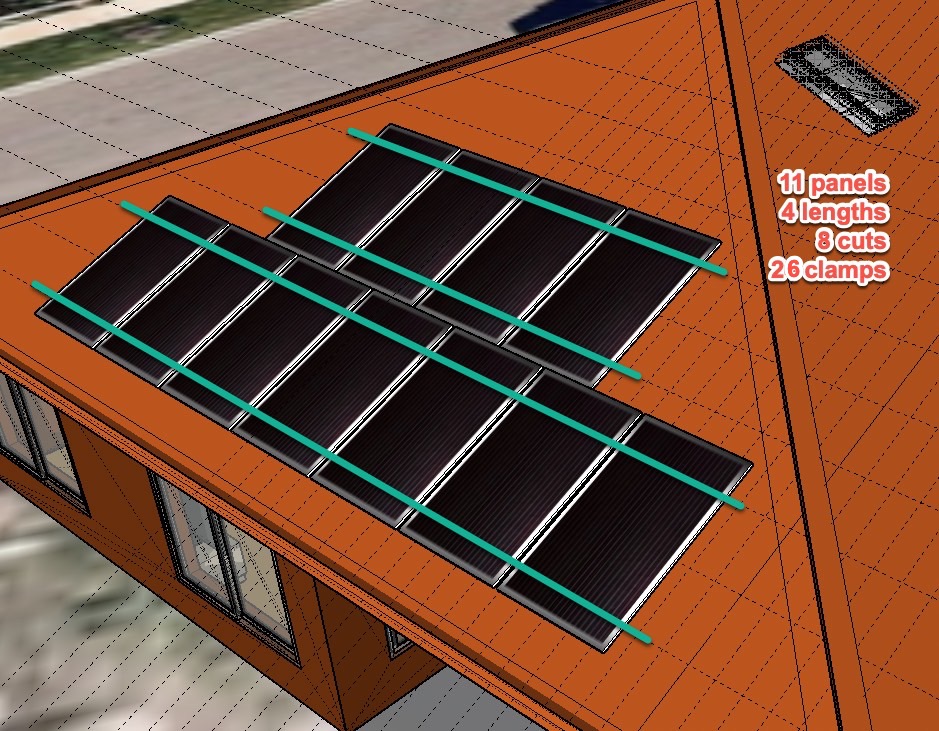
 RSS - Posts
RSS - Posts



There is a problem with landscape mounting. I had to remount mine myself.
Solar cells are all in series but arranged in 3 sets of 24 cells with a bypass diode across each group of 24 cells. 3 diodes per 72 cell panel.
When a vertical shadow from a tree trunk or pole passes over the solar panel it will disable one 24 cell section at a time and we loose only 24 cells in the total string and not 72 cells.
With landscape mounting, a vertical shadow will disable 6 cells, 2 in each group of 24 cells and disable the entire panel of 72 cells.
Not a problem if you don’t have shadows. I do.
I learned the hard way.
Fortunately this was my auxiliary array and not my main array.
When mounting solar panels in either portrait, landscape or a mixture of both, it does need to have shading taken into account before maximising the number of panels your roof will allow.
One of the very highly respected Melbourne solar installation companies, highly rated from customers on this site, has mapped out both orientations for our upcoming upgrade install with LG panels and Enphase micros.
Thankfully, most of our long roof faces north and is not hard shaded, so it was easy to arrange both orientations to maximise the number of panels.
The designer took the time to think about our requirements and met them using both orientations.
We are looking forward to them installing our LG/Enphase combo system in the coming weeks.
When using micro inverters, 1 per panel, it’s a better solution but much more expensive.
Bob
I think that you have missed an important point in the choice of portrait vs landscape orientation of panels, and that is temperature. With a corrugated iron roof and portrait panels, you will get a higher buildup of heat under the panels because there is less space under the panels for two reasons.
1.the rails are crossing the corrugations thus forming little dams trapping the heat.
2. The panels are close mounted
to the rails, further restricting the flow of hot air.
With a corrugated iron roof and landscape panels, you will get a chimney effect with an unimpeded flow of hot air up and away from the panels being constantly replaced with cooler air from the bottom of the panels.
Plus, because the rails are fitted to the top of a corrugation, and the panels are fitted to the top of the rail, you will get a greater clearance under the panels.
I have read that heat is the enemy of pv.
So it just makes sense to me that reducing heat buildup under panels is a good thing.
Regards
Andrew
PS I have no experience with tiled rooves
I think this is an often overlooked aspect of landscape panels.
An often overlooked problem is that solar panels don’t like heat, and it makes sense that landscape would help cool them, especially on a metal roof.
Hi Andrew, I’m also tending to go landscape orientation , mainly for the reasons of heat escape under the panels. I think most panels ( landscape or portrait), are hard butted up to each other.I was also thinking of having a gap ( say 25mm) between every panel, so it can be easier still for heat to escape, ( but the gaps might be a spot for wind/ leaf/ twigs build up, so maybe not so good an idea). My house is rather large ( i’m a builder). It’s long and while I initially didn’t like the asthetics of landscape orientation, I changed my mind , because landscape will look more streamlined and be in keeping with the long house, as opposed to portrait orientation, which might give a boxed/ shorter look.That’s just asthetics. I’m using 30 panels and thinking of having a 700mm middle gap ( pathway from gutter to apex) ( 15 panels either side), for access to maintenance. I’m mildly concerned about big hail ( how unlucky could I be)? I was thinking ( later project) of installing an ” emergency cover” to roll from the top down to the bottom ( similar to what to what pools have that roll out a cover)and pack it up after hail is finished / might look pretty ugly on the roof though. Sounds a bit overkill, but a 15- 20 K investment might be worth protecting, instead of claiming insurance and increased premiums.I would have thought there would be something out there in google land to cover solar panels, but I have yet to find any.
More expensive compared to what?
Compared to a string system with 1 inverter per system.
Thanks Fine. It was a rhetorical question. When making a comparison, compare rather than state.
Hi David,
Just wondering if you have installed your solar system in different orientations (landscape and portrait) and found no issues. Is your roof tiled?
Thanks
Hi Chrys,
Absolutely no problems at all. I have a truckload of panels on my roof in portrait, landscape and diagonal orientations. Panels face north and west. No shading.
Roof has concrete tiles. No problem with the tiles. No problem with my pv solar either. Now 1 year 3 months old. Upgraded from a system I had installed in late 2010.
Thanks David. We can only have 12 (portrait) in the North and West. However, we would like to have at least another 4 in the North as well. We are keen to have 3 phase but we could not find a 3phase, 3MPPT inverter. Fortunately, we don’t have any shading issue. So one company suggested an expensive hybrid solution. Another reputed company (suggested by Solarquotes) has given a proposal with 15 landscape in North and West using 3Phase 2MPPT inverter (price wise better). Both has pros and cons. So, we don’t know which one to select.
Hi Chrys,
I have Enphase micro inverters, so I cannot comment on what you’re considering. For me, it’s micros each and every time.
Yes – this is what I meant in Footnote #1. Interestingly the shading effect is the other way round with half-cut panels – which is becoming the standard cell configuration. Conventional panels (LHS on diagram) work best with big shade encroaching on the long side. Half cut panels work best with big shade encroaching from the short side.
Finn. You did did a post on shading on shingle I recall. Keen to compare various half cut and Hyundai shingle panels in portrait and landscape on roof that has shading. Using Enphase micros.
Hi Finn, I think you’ve dropped off a couple of clamps in your ‘portrait’ example — shouldn’t it be 26 clamps, not 24? 🙂
Well spotted, I’ve fixed the post. It is a good idea I didn’t need to be able to count to pass the engineering exams!
Engineer answer to 2+2
5 (to be on the safe side).
Thank you for this information ….
Thank you for raising my awareness of the fringe considerations of solar. I appreciate you sharing your knowledge.
Are Micro Inverters safer on a metal roofed house that has an attic veranda and the metal colorbond roof is easily touched????
A well-installed properly earthed string system is safe. The earthing will prevent the roof getting live.
A micro inverter system never gets above 230V AC compared to up to 600V DC for a string system. So it is inherently safer. If something goes wrong – the consequences are less severe.
I got micros on my straw house for that reason.
Not mentioned in this, but is it possible to have a split design where most are portrait but you have a bottom, or top, row done landscape?
Roof issues mean our panels are split between north, and east + west sides, yet still didn’t reach the recommended 133% loading. Not a major problem, but I am curious.
Yes – mixed portrait and landscape can be a good option.
After reading Solar Quotes invaluable information for a long time, and observing shadowing on the roof for more than a year, I finally took the plunge. My installation was challenging, but the installer (recommended by Solar Quotes), Green Sky Australia, was undaunted, installing 24 x 370W panels and Enphase microinverters, last week. These are split panels, installed on three separate sections of the roof. The shadowing on one section of eleven panels required the seven lower panels to be portrait, as the shadows encroach from the short side, and the upper four to be landscape, so they would all fit. The result looks great. A testimonial to Green Sky will be posted separately, explaining how the challenges were overcome.
Another benefit of vertical rails is that they won’t collect leaves. Horizontal rails accumulate a great deal of debris which becomes a fire hazard in summer as well as trapping moisture in winter. It’s almost impossible to clear them out without removing each panel.
Good point Rod. I have had two installations done, both down wind of large gum trees. Lucky I insisted on landscape orientation!I never thought about leaf litter and the consequences.
The first one was using micro inverters and over time, the cables sagged a bit despite being clipped up out of the way. Spiders made webs between the cables and the panels, which caught the odd leaf, however the bulk of the space was clear and was easily inspected from the ground. I reckon a blower could have been used from the ground if leaf litter ever became a problem. The second install has a large gum tree upwind and so far no leaf litter problems under the solar panels.
The grounds are just covered in leaves and twigs after a bit of wind. Designers take note. Landscape orientation is the best way to go for more than one reason.
Regards
Andrew
Totally agree, my system is fitted portrait style, and I have lots of trees to the south and there is always a stack of leaf debri caught under them that is hard to remove.
My installation of 24 panels (both portrait and landscape) was only last week, so I am not yet qualified to talk about leaf litter on portrait panels, however the panels sit a minimum of 40 mm above the solar array frames on the peaks of my colorbond roof, and 55 mm (approx.) above the valleys. I will be very surprised if leaf litter can build up below such clearances, particularly with the rainfall on the Mornington Peninsula. The frames are made by Chiko, used by my installer for many years, and came with a comprehensive Australian structural engineering report. Eucalypts drop leaves on the roof, but I do not foresee that being a problem. If build up does occur in autumn when a large claret ash nearby drops its leaves, my leaf blower will handle that, because of the gap between the roof and the panels. I will report my experience with leaf litter in 12 months time.
The leaf litter that I have experienced is not between the panels and the roof but between the mounting frames and the roof. A standard corrugated iron roof leaves only about 25mm clearance between the valleys and the frame and that is where I have the issue. Of course once those valleys are blocked, then leaves start to get trapped on the high side of the frames below the panels.
I have found it difficult to move the leaves with a blower; a couple of panels in from the end of a row and it just doesn’t have enough strength. It might work if done very regularly before the leaves start to stick to the roof and each other which is what happens when it rains.
If I knew that earlier I would have asked for landscape orientation.
As advised previously, the distance between the bottom of the frames and the valleys in my installation is 55 mm.
I have both orientations on my house. After installing solar on my 2 story steel roof I regretted it almost immediately. Pigeons moved in the very next day and love those horizontal rails! It’s perfect for them to get under the panel and sit on the rail. The noise they made could only be described as enormous, it started at the crack of dawn and continues until sunset.
It’s all bird proofed now but the pigeons stayed another 4 months after that because they still considered it home.
If you have a 2 story steel roof, don’t forget to price in another $1700 or so to get it properly bird proofed or you risk living in the noisiest house you have ever owned. Particularly if you have horizontal rails.
I love my solar, but that made for a miserable year trying to get rid of those pigeons! I think bird proofing is a very under discussed aspect of solar, particularly 2 story – I had no intention of going on my roof myself, too risky!
Ah that’s a point no installer brought up at the time of the quotes and I wasn’t aware to ask 3 years ago. Bit of a bummer as I would have liked more panels at the time but thought I was at my limit and they had configured them appropriately for the roof space. As it turned out on installation day, some panels were turned into landscape mode for one verandah section of roof as they would exceed to 200 mm edging, and another was rearranged to get more on the upper storey,but now I wonder if the others could have been configured differently then too.
I had my Longi 370W (2m) panels installed landscape but using horizontal (portrait) racking.
The installation guide allows for it. I had to do some homework to make sure the panel mounts were in the clamping zone, but it seemed to work out for my standard roof tile vertical spacing (approx 600-800mm per 2).
It does use 25% more racking and mounts. Well worth it to avoid using my south east facing roof.
Note1: not all panels are suitable, some need additional bracing, and due to the span, may not be suitable for Snow Loading – Not an issue here in Perth,WA.
Note2: A lot of installers (budget,Rushjob) told me it couldn’t be done, preferring to do the install on my large, southerly facing roof.
As a retired structural engineer living in a tropical cyclone region, I analysed the installation of 26 panels on my roof and concluded that portrait orientation was a poor solution because it resulted in either the rail spacing specified by the panel manufacturer being exceeded or a reduced the number of panels on my roof.
I believe landscape panel orientation is nearly always a better structural solution because it makes the roof batten or purlin spacing irrelevant when laying out the rails to suit the panel manufacturer’s requirements.
My installer did not charge more for the landscape orientation.
I have both orientations, the house (clay/tile roof) has 16 panels in portrait. My shed has 15 in landscape. All with Enphase micro-inverters. My installer (G Store Solar) went through why the difference and were good with communications about this. The house was installed about a year and 1/2 before I got the extra 15 on the shed (and a house battery).
Any issues with a mix of portrait/landscape panels on a concrete tile roof? One installer claims it can’t be done (pretty sure they’re more on the sales side than the engineering side) while the other says it’s no issues.
Provided the installer knows what they are doing, it can be done. That said, with solar installation on any tile roof, it is important to have spare tiles on hand to replace any that get broken.
The PV panels should keep your roof cooler all year as it shades the roof surface.
Reduces the load on the air conditioning cooling cycle.
Dismiss anyone who says it can’t be done. It’s common practice to mix orientations. May help to increase the number of panels that can be installed on the roof. If they can install portrait, they can install landscape.
We have that setup on our concrete tiled roof and in fact, we have one west facing panel at around 45 degrees rotation to match the pitched roof angle. It’s one of the highest performing panels. (We have Enphase micros and I can monitor panel level production).
Installer, who owns the company said it wasn’t any problem at all. In fact the designer (employed by the company) who calculated the orientation & quoted had a number of panels in landscape from the outset.
Initially possibly, but as the air temperature stays high for just a few days on end, I don’t feel any shading benefits. I have a truckload of panels (65) on my roof, so I can, from first hand summer temperature experience, comment with a little authority.
Don’t expect it, so you won’t be disappointed. Ensure your roof space, walls and windows are properly insulated from the start. Of course, if you have an older, established home, that could be impossible to do unless you renovate accordingly. So insulate as best as possible.
Any panel shading benefit afterwards is a bonus.
Thank you for the feed back.
I have an attic room and it crossed my mind that it could help.
I have a ‘difficult’ terracotta roof and my first quote was based solely on a Google Earth roof shot and showed all (Jinko JKM370M N TYPE MONO PERC) 18 panels laid landscape. I’m not sure that they all fitted well, but I don’t know how accurate the panel shapes are in scale. The design was very acceptable.
My second quote, following a visit from a salesman/designer, all panels were drawn portrait and not pretty (he did warn me!). When I asked about landscape he said it couldn’t be done as the roof purloins would not be in suitable places. Is he correct or just avoiding a difficult fit. He suggested 17 Hyundai PERC Shingled Tier 1 390W panels.
Hi Les.
If an installer only looks at a Google Earth picture, they are not going to be able to tell the location of the roof purlins. This can result in an installer showing up in their truck, all ready to put a system on, and then saying they can’t do it. When an installer comes to your home and does an on-site inspection, they can check the roof structure and know for sure what they can put on. It’s very likely the second installer is being honest. But if you are concerned, you can check the company’s online reviews to see if they have a good reputation and treat people fairly. If you were referred to them through us, we will back up their work with our Good Installer Guarantee:
https://www.solarquotes.com.au/installation-guarantee/
If you haven’t gotten quotes through us and want some more to see what your options are, you can get some here:
https://www.solarquotes.com.au/quote/start/
Of the solar panels offered, both brands – Jinko and Hyundai – are reliable and can be expected to operate for decades without problem.
A landscape installation should be easier and possibly more compact as the solar support rails are at right angles to the purlins/battens. This means that the rail spacing is not dictated by the purlin/batten spacing and can be optimised to suit the panel dimensions.
This can be even more advantageous for metal roofs and allowed me to have 26 landscape panels installed on my roof in the space that 20 portrait panels would have taken up. This is because the 26 landscape panels are spaced closely together whereas the portrait panels would have had significant spaces between some rows.
My installer did not charge any extra for the landscape installation.
A big advantage of the landscape configuration is that the rails run up and down the roof which means they do not trap leaves or provide a good place for Indian Mynah birds to nest. Cleaning the roof is very easy too.
Hi there,
I currently have total 19 panels on my roof in two strings of 11 and 8 ea. All are installed in portrait and on the same plane as the roof approx 20deg. All face NW.
I need to remove 2 panels from the 8 panel string to make room for a fireplace flu.
I have space on the roof to reinstall 1 of the panels in landscape orientation still in NW direction and still in same plane as the roof. In effect making 1 of the strings 6 portrait and 1 landscape.
In principle do you see any issues?
Look forward to your wisdom
Hi Alistair
I see no issues with mixing up the panel orientation as long as you keep to the support recommendations of the panel manufacturer so they can withstand the appropriate loading and the warranty is not voided.
For example, my JA panels are clamped down on the long sides at L/4 +/- 50mm from the corners because I am in a high wind area. For normal load areas they recommend clamping on either the long or short sides within L/4 of the corners. These recommendation only apply to particular JA panels and other models or makes may be different.
Download the installation manual for your panels and check out the support recommendations before going ahead.
Hi Fin,
Nice post, I see you used the SketchUp model of my house that I made (Would be nice if you provide me with the credit).
Also, I’m finally getting ready to install the solar panels after a long delay from builder, I will maximise the number of panels combining portrait and landscape.
I will install 51 390 W to use a 15KW string Inverter (Goodwe GW15KLV-MT). Also, I will avoid locating some panels where where the shade from my neighbour’s house lands and I will use some optimiser here the shad is not that much.
Regards,
Hi Juan.
An image credit has been added.
Beware the installer that says they will use landscape orientation (this of course allows the assumption that all rails will be positioned perpendicular to the gutter-line) BUT, THEN the installer positions the rails parallel (easier/cheaper/quicker) to the gutter-line orientation and THEN uses the “short-side” of the PV panels to clamp landscape!
This leaves the “long-side” of each panel without clamps.
NOT ALL panels (brands/models) are allowed/warranted/recommended for these (short-side) clamp positions. (Plus, (I believe that) wind loading IS superior with clamps on the “long-side” of panels.)
My install: “Solaray” did not and/or refused, to “grind/cut” ANY of the terracotta roof tiles for ANY method of “Z” interface bracket install.
Also, if perpendicular rails are fitted, this would “force” the installer to grind/cut the terracotta tiles to accommodate the “specialised” “Z” roof-to-rail interface bracket! Another reason the installer takes the (parallel) “shortcut” on the (tile roof) install… it takes that much more time to fit the brackets for perpendicular rail positioning!
Perhaps a discussion is needed re. landscape panels on parallel (to gutter line) rails…
(Footnote: IMHO a “quality” installer will ALWAYS grind/cut concrete/terracotta roof tiles as needed/mandated by the interface bracket manufacturer!… As my install was some years ago… perhaps Solaray have changed their hardline policy on this aspect of install…?)